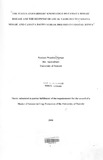| dc.description.abstract | Cassava Mosaic Disease (CMD) and Cassava Brown Streak Disease (CBS D) are the
mainbiotic constraints to cassava production in coastal Kenya. A survey to document the
incidence and severity of CMD and farmers' knowledge and perceptions on the disease
was carried out in the region in October 2005. A total of 27 cassava fields were visited
and the disease incidence and severity determined. A semi-structured questionnaire used
to obtain information on farmers' knowledge on the disease. The incidence of CMD
ranged between 73-100% among the surveyed fields. The dominant type of infection was
cutting borne whereas the whitefly borne infection was lower and positively correlated to
the Bemisia (abaci vector counts. Co-infection with both CMD and CBSD was common
in all the districts but was highest (85%) in Lamu and lowest (10%) in Malindi.
Kibandameno was the most popular variety in the region followed by Agriculture,
Kahutele and Kaleso in a descending order. The results of a semi-structured questionnaire
administered to the farmers showed that majority of the farmers (48%) obtained planting
materials from the previous season's crop. Majority of the growers could recognize the
disease but only 7% attributed it to viruses. In addition, 84% of the interviewees did not
employ any management practices against CMD. Though 52% of the interviewees had
observed varietal differences in disease susceptibility, they continued to grow the
susceptible ones due to their superior culinary properties (34%) and lack of planting
materials (7%).
An experiment to determine the role of selection of clean planting materials and roguing
for the management of CMD was carried out in two growing seasons. Bemisia (abaci
population was monitored on a net plot of 20 plants for the first five months of growth,
Roguing of diseased plants was carried out in the first month after planting. The monthly
disease severity was monitored monthly for all the plants in each plot for eight months.
The plant height was measured monthly for all the plants in the net plot for eight months.
The crop was harvested at 10 months after planting and the number of roots, number of
marketable roots and total root weight for each of the plants in the net plot were
measured. The plant height and B. tabaci count were not significantly (P~0.05) different
between the treatments. The disease incidence and severity were higher in randomly
selected materials compared to the clean ones. All the yield parameters determined were
not significantly (P~0.05) different between the treatments in the short ram season.
During the long rain season only the number of marketable roots was significantly
(P::;0.05) different among the treatments.
The response of local germplasm to co-infection with CMD and CBSD was determined
in field experiments using three varieties popular in the region namely Kibandameno,
Guzo and Kaleso. The control comprised of clean planting materials. Disease severity
was determined for all the plants in the net plot. The plant height was also measured for
all the plants in the net plot. Kibandameno was the most susceptible variety to both CMD
and CBSD. Kaleso ranked second in susceptibility to CMD, on the other hand the variety
did not show any CBSD symptoms during the vegetative growth period. In all the three
varieties, the clean plants produced roots of highest quality and quantity compared to the
virus infected ones. Yield losses due to CMD were higher when compared to those of
CBSD. In Guzo, there was no significant (P~0.05) difference in root yield parameter
between the clean and CBSD infected plants. Qualitative and quantitative yield was
highly reduced in Kibandameno. The yield loss ranged from 6-53%, 15-62%, 33-90%
and 41-61% for root length, total root counts, marketable number of roots and root weight
respectively. Yield reduction was due to reduced root weight and number of roots in
CMD infected plants. In CBSD infected plants, yield reduction was due to severe root
constriction and pitting. Plants having mixed infections with CMD + CBSD had the
highest yield reduction. Co-occurrence of cassava mosaic and cassava brown streak
diseases threatens cassava production in coastal Kenya. | en |

